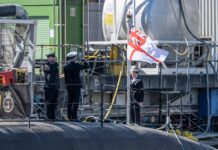The United Kingdom’s naval construction sector has been undergoing a significant revival in recent years. Multiple procurement programmes are currently underway to support a much-needed modernisation of the British Royal Navy (RN). The recently revealed results of the 2025 Strategic Defence Review (SDR 2025) herald a further expansion of the sector, with the submarine segment likely to be a significant beneficiary. However, detailed prospects for naval construction will gain more clarity after the expected publication of a detailed Defence Investment Plan, as well as of a long-awaited Defence Industrial Strategy, before the year’s end.
Overview
The United Kingdom retains one of the world’s largest naval construction sectors, maintaining the ability to design and build a full spectrum of vessels. In contrast to many of its European peers, its activities are particularly heavily weighted towards national naval requirements, meaning relatively few ships have been built for export in recent years. The industry has, however, achieved success in selling designs for overseas construction under transfer of technology agreements. It also remains an important supplier of naval equipment.
Domestic demand for warships has grown substantially over the last decade. The block obsolescence of the RN’s Cold War-era ships has driven the need for increased procurement and this has been supported by a modest yet steady uptick in defence spending. Recent government announcements to accelerate defence spending to reach an initial 2.5% of gross domestic product, with an ambition to go further thereafter, suggest that this trend will continue. The recent SDR 2025 is also supportive of additional naval investment. However, it makes few tangible commitments beyond setting a target for the acquisition of SSN-AUKUS (SSN-A) nuclear powered attack submarines under the so-called Pillar I of the tripartite security agreement. As discussed later in this article, many detailed decisions have still to be revealed.
The importance of the British shipbuilding sector is reflected in the publication of a National Shipbuilding Strategy (NSS) in 2017, which was subsequently refreshed in 2022. Both documents were aimed at revitalising and expanding the overall indigenous maritime industrial base. Their scope also extended to shipbuilding and equipment for commercial requirements but not submarines. These have typically been considered as a discrete segment by virtue of being part of the UK’s wider nuclear enterprise. The 2022 NSS set out a 30-year pipeline of planned government shipping procurement to help inform industry of future demand. However, whilst acquisition of complex warships has essentially been restricted to British shipbuilders, policy is notably more flexible than that adopted by many countries with respect to the origin of other ships. At present, it is not clear to what extent the current British government will maintain the existing NSS approach.
Following reversal of a previous policy of consolidation, British warship construction is currently split between three major suppliers. The largest of these is BAE Systems. Its facility in Barrow-in-Furness is the only British site capable of building submarines, whilst its integrated shipyards at Govan and Yarrow in Glasgow comprise the UK’s largest builder of major surface vessels. Babcock International Group, who recently upgraded their shipyard at Rosyth near Edinburgh, is also involved in surface warship construction following its award of the contract for the Type 31 frigate programme. These two British-owned companies have recently been joined by the UK arm of Navantia, following the Spanish group’s acquisition of the former Harland & Wolff business in January 2025. Its main facility is the famous Harland & Wolff yard in Belfast. However, the purchase has also brought the Appledore shipyard in Devon and two smaller Scottish facilities focused on the commercial sector under its wing.
In addition to their shipbuilding sites, both BAE Systems (at Portsmouth) and Babcock (at Devonport and Faslane) maintain important maintenance and refitting facilities. Also of note are the shipyards of APCL Group. These maintain the naval support vessels of the Royal Fleet Auxiliary (RFA) and, alongside Ferguson Marine in Glasgow, are supplying block assemblies for BAE Systems’ warship construction. The activities of the prime shipbuilding contractors also support a very extensive ecosystem of suppliers. Amongst these, the various naval propulsion businesses of Rolls-Royce Group and the UK operations of Atlas Elektronik, MBDA and Thales are particularly prominent. Many British contractors have gained strong niche positions within their areas of expertise; BMT (ship design), David Brown Santasalo (gearboxes), MacTaggart Scott (lifts and handling equipment), MST Group (high-speed boats) and Ultra Maritime (sonar) are just a few examples in this regard.
Submarines
The British naval construction sector is dominated by submarine building. This forms part of the wider Defence Nuclear Enterprise, which is focused on the maintenance of the UK’s strategic Continuous At-Sea Deterrence (CASD) capability but also includes conventionally-armed, nuclear-powered attack submarines (SSNs). The overall enterprise cost GBP 10.9 billion in the 2024/25 financial year, approaching 20% of the British Ministry of Defence’s entire equipment budget. Total spending is expected to increase over the years ahead, amounting to around GBP 130 billion during the next decade.
![BAE Systems is Britain’s sole submarine manufacturer. This photograph shows HMS Agamemnon, the sixth Astute class SSN, at the time of her launch in October 2024. [BAE Systems]](https://euro-sd.com/wp-content/uploads/2025/09/1_Agamemnon-Kopie-1024x683.jpg)
BAE Systems is currently involved with the design and production of three classes of nuclear-powered submarines at various stages of programme maturity. The oldest is that for seven Astute class SSNs, the first three of which were ordered as long ago as March 1997. The project has been marked by the delays and attrition of relevant skills that marked the immediate post-war era. Concerningly, there has been little if any increase in the slow pace of construction between the earlier and later submarines in the class. At present, BAE Systems is close to delivering the sixth boat, HMS Agamemnon, which was launched in October 2024. Later that month, a fire broke out in the Devonshire Dock Hall where submarine assembly takes place. It has been speculated that this may delay delivery of the seventh and final member of the class, HMS Achilles (formerly HMS Agincourt), which remains under construction.
Part of the reason for the slow pace of progress with later members of the Astute class may be the strain on resources caused by the transition to the construction of the four Dreadnought class strategic submarines that will replace the existing Vanguard class boats in providing CASD. As of May 2025, the programme remained within its GBP 41 billion – including a GBP 10 billion contingency – budget, with a total of GBP 17.4 billion having been spent to March 2024. The first steel was cut for the lead boat in October 2016, and was followed by a formal keel laying ceremony in March 2025. Dreadnought reportedly remains on track to enter service in the early 2030s. Work has also started on the second (Valiant) and third (Warspite) submarines, with long-lead items and other materials procured for the fourth (King George VI) and final member of the class.
![A formal keel-laying ceremony for the lead Dreadnought class strategic submarine was held in BAE Systems’ Devonshire Dock Hall at Barrow-in-Furness in March 2025. [BAE Systems]](https://euro-sd.com/wp-content/uploads/2025/09/3_Dreadnought-keel-laying-Kopie-1024x683.jpg)
In one of the major developments to emerge from SDSR 2025, the UK MoD has decided to build “up to 12” Royal Navy SSN-As, almost double the number of the planned Astute class flotilla. This will be achieved by leveraging the investment made in the submarine industrial base to achieve a construction drumbeat to one submarine every 18 months. Whilst remaining lower than the production rate achieved during the Cold War, this seems to be an ambitious target given the delays that have impacted recent production, but reflects the importance attached to securing the underwater domain given ongoing Russian investment in modernising its own submarine arm.
Surface warships
The extent of British investment in submarine capabilities has inevitably given rise to questions about the resources that will be available post SDR 2025 to fund the previously planned expansion of the Royal Navy’s surface fleet. At present, procurement has been authorised for two classes of frigate intended to maintain the 2010 target of 19 major surface combatants. However, whether aspirations to further increase this number to up to 24 major warships will be achieved is a matter of some conjecture.
The flagship surface warship construction programme is for eight ‘high-end’ Type 26 anti-submarine warfare frigates. Three of these ships were ordered from BAE Systems at a cost of GBP 3.7 billion in 2017. A GBP 4.2 billion contract for the remaining five followed in 2022. Fabrication of the lead ship, named Glasgow, commenced in July 2017 and, as of mid-2025, work on five of the frigates was underway. In a similar but rather less ambitious fashion to the submarine business, their construction is being supported by a major programme of investment in BAE Systems’ Clyde shipyards, which is reported to amount to GBP 300 million overall. Its centrepiece is the new covered Janet Harvey Hall at the Govan yard in Glasgow that allows the simultaneous assembly of two Type 26 frigates in a controlled, weather-tight environment. The facility was officially opened in June 2025 and is being used for the assembly of all the Type 26 frigates from the third vessel onwards.
![The Janet Harvey Hall has been built at BAE Systems’ Govan shipyard to support construction of the Type 26 frigate class. [BAE Systems]](https://euro-sd.com/wp-content/uploads/2025/09/5_Janet-Harvey-Hall-Kopie-1024x768.jpg)
The Type 26’s ‘Global Combat Ship’ export iteration has already formed the basis of similar warship construction programmes in the shape of Australia’s Hunter class frigates and Canada’s ‘River’ class destroyers under transfer of technology arrangements. Firm orders for three of each type had been placed by mid-2025 as part of larger projected programmes. Whilst construction of all these ships will take place overseas, the design’s selection will result in substantial orders for the British Type 26 supply chain. The Type 26 is also one of four contenders alongside proposals from France, Germany and the United States for Norway’s programme to import at least five new frigates. Selection of the preferred supplier for a hotly contested order was believed to be imminent at the time of writing.
The other component of British surface warship construction comprises five general purpose frigates being built by Babcock at Rosyth. Intended to be a disruptive programme designed to increase competition in the supply of Royal Navy warships, the acquisition was carried out under a fixed-price contract with a reported value of around GBP 1.25 billion (exclusive of certain government furnished equipment). This arrangement has already proved costly to Babcock. It has had to take provisions totalling GBP 190 million on the agreement due to the impact of the COVID-19 pandemic and higher-than-expected cost inflation. On the plus side, the ‘Arrowhead 140’ design – itself based on Denmark’s Iver Huitfeldt class – has already gained important transfer of technology contracts for the construction of two ships in Indonesia and three in Poland.
![The lead Type 31 frigate Venturer seen exiting Babcock’s Venturer Building at Rosyth in May 2025. [Conrad Waters]](https://euro-sd.com/wp-content/uploads/2025/09/7_Venturer-Kopie-1024x742.jpg)
Other naval construction
The other major naval British construction programme currently underway encompasses three fleet solid support ships (FSSs). Designed by BMT, these auxiliary vessels are intended to provide non-liquid replenishment for carrier strike groups and other warships. A GBP 1.6 billion contract for the ships’ construction was awarded to the Navantia-led Team Resolute in January 2023. The agreement envisaged assembly of the FSSs at the Harland and Wolff shipyard in Belfast from blocks fabricated by Harland and Wolff group’s Appledore and Belfast facilities, as well as by Navantia’s own yard at Puerto Real near Cádiz. It involved significant investment to modernise the Belfast site, which had not completed a new-build ship for 20 years. At the time the contract was signed, it was envisaged that all three ships would be operational by 2032. Implementation of the contract was subsequently disrupted by the financial insolvency of Harland and Wolff, ultimately leading to the group’s acquisition by Navantia in January 2025. The Spanish group has now resumed modernisation of the former Harland & Wolff shipyards.
![A computer-generated image of BMT’s fleet support ship design for the Navantia-led Team Resolute. BMT is one of numerous specialist companies supporting the British naval construction sector. [Team Resolute]](https://euro-sd.com/wp-content/uploads/2025/09/2_Fleet-Solid-Support-Ship-Kopie-1024x427.jpg)
Looking to the future, Martínez anticipated that Navantia UK would continue to support government programmes, including through component manufacturing and specialist capabilities. He explained, “Our GBP 115 million investment programme reflects that vision, ensuring all four sites are equipped to contribute to the UK’s long-term sovereign defence and industrial objectives”.
Table 1 provides an overview summarising the current state of the Royal Navy’s construction programmes.
| Table 1: Current British Royal Navy warship construction programmes | ||||||
| Class | Type | Displacement | First ordered | Total requirement | Completed | In construction |
| Submarines | ||||||
| Astute | Nuclear-powered attack submarine (SSN) | c. 7,500 tonnes | 1997 | 7 | 5 | 2 |
| Dreadnought | Nuclear-powered strategic submarine (SSBN) | c. 17,000 tonnes | 2016 | 4 | 0 | 3 |
| SSN-AUKUS | Nuclear-powered attack submarine (SSN) | n.k. | Tbd | Up to 12 | 0 | 0 |
| Surface Vessels | ||||||
| Type 26 ‘City’ | Frigate (FFG) | c. 7,000 tonnes | 2017 | 8 | 0 | 5 |
| Type 31 ‘Inspiration’ | Frigate (FF) | c. 6,000 tonnes | 2019 | 5 | 0 | 5 |
| Auxiliaries | ||||||
| Solid Support Ship | Replenishment ship (FSS) | c. 40,000 tonnes | 2021 | 3 | 0 | 0 |
| Note: SSN-AUKUS has had design and initial long-lead items ordered. | ||||||
The way ahead
The longer-term future for the British naval sector is inevitably subject to securing orders for new construction. The submarine segment has most security in this regard, with the SSN-A programme providing visibility for decades into the future. The picture with respect to surface ship construction is far less clear, as important elements of the 30-year pipeline of requirements outlined in the 2022 NSS have already been overtaken by subsequent developments. The imminently expected Defence Investment Plan that will follow on from SDR 2025 should do much to provide the desired clarity, and according to UK Secretary of State for Defence John Healey, promises “line-by-line” detail of future equipment required. If this ambition is delivered, the plan will be of much greater utility than previous recent British defence documents. These have tended to lack considerable detail as to planned force structures and intended procurement.
On the face of it, the expanded funding envelope should be sufficient to provide enough work for the surface yards and supporting sub-contractors. The 2022 NSS encompassed requirements for an undefined number of anti-air warfare ships – now commonly referred to as the Type 83 destroyer – and “up to five” follow-on Type 32 general purpose frigates. These were supplemented by plans for what are now known as multi-role strike ships (MRSSs) and various smaller vessels and support shipping. SDR 2025 explicitly endorses only some of these requirements – the anti-air warfare “air dominance system” being a notable example – and paints a vision where there is significant use of autonomous systems to bulk out crewed platforms and provide additional mass. It is known that the Royal Navy are already developing Type 92 uncrewed sloop and Type 93 uncrewed underwater vehicle concepts to work alongside the Type 26 frigates and other platforms to secure maritime dominance in what is referred to as the ‘Atlantic Bastion’. Equally, a fleet of Type 91 missile ‘barges’ is envisaged to supplement the magazine capacity of the Type 83 destroyers. Implementing these concepts would have a significant impact on the shape of the future shipbuilding programme and the nature of shipyard capacity required.
![XV Patrick Blackett is being used to explore prototype technologies for a new generation of uncrewed surface vessels designated the Type 92. Such uncrewed vessels are likely to form an increasingly significant part of future Royal Navy construction programmes. [Crown Copyright 2024]](https://euro-sd.com/wp-content/uploads/2025/09/8_Patrick-Blackett-Kopie-1024x683.jpg)
Conrad Waters
Author: Conrad Waters is a naval and defence analyst. He is Editor of Seaforth World Naval Review, Joint Editor of Maritime Defence Monitor and a regular contributor to other Mittler Report publications.



![4_SSN-AUKUS Kopie Construction of SSN-AUKUS submarines will support the UK’s submarine industrial base for decades ahead. [Crown Copyright 2024]](https://euro-sd.com/wp-content/uploads/2025/09/4_SSN-AUKUS-Kopie.jpg)









